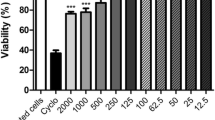Abstract
Gliotoxin, an epipolythiodioxopiperizine mycotoxin, has been shown to be produced by, among other fungi,Aspergillus fumigatus Fresenius. This organism is the major causative agent of the respiratory disease aspergillosis in avian species, especially turkeys. Because gliotoxin has been shown to be immunosuppressive and has the potential for being involved in the pathogenesis of aspergillosis, the in vitro activity of this compound with avian lymphocytes was investigated. Immunosuppression was investigated using peripheral blood lymphocytes from turkeys in a lymphoblastogenesis assay and a cytotoxicity assay using conversion of the tetrazolium salt MTT to MTT formazan by the mitochondrial succinate dehydrogenase enzyme elaborated only by living cells. Gliotoxin appeared to have a threshold level in both tests because little or no response or stimulation was evident when cells were exposed to concentrations of the toxin below 100 ng/ml, but at 100 ng/ml, all cells appeared to be dead. Using T-2 mycotoxin as a known cytotoxic agent, the response in the MTT bioassay using turkey peripheral lymphocytes was linear with increasing concentrations of toxin. Gliotoxin may potentially cause immunosuppression in turkey poults through action on the lymphocytes or if this toxin were present in low concentrations stimulation could possibly occur.
Similar content being viewed by others
References
Richard JL. Additional mycotoxins of potential importance to human and animal health. Vet Human Toxicol 1990; 32 (Suppl.): 63–70.
Taylor A. The toxicology of sporidesmins and other epipolythiodioxopiperazines. In: Kadis S, Ciegler A, Ajl SJ (eds), Microbial Toxins, Vol. 7. New York: Academic Press, 1971: 337–76.
Boutibonnes P, Auffray Y, Malherbe C, Kogbo W, Marias C. Proprietes antibacteriennes et genotoxiques de 33 mycotoxines. Mycopathologia 1984; 87: 43–9.
Johnson JR, Bruce WR, Dutcher JD. Gliotoxin, the antibiotic principles ofGliocladium fimbriatum, I: Production, physical and biological properties. J Am Chem Soc 1943; 65: 2005–9.
Müllbacher A, Eichner RD. Immunosuppression in vitro by a metabolite of a human pathogenic fungus. Proc Nat'l Acad Sci 1984; 81: 3835–37.
Müllbacher A, Waring P, Eichner RD. Identification of an agent in cultures ofAspergillus fumigatus displaying anti-phagocytic and immunomodulating activity in vitro. J Gen Microbiol 1985; 131: 1251–58.
Müllbacher A, Hume D, Braithwaite AW, Waring P, Eichner RD. Selective resistance of bone marrow derived hematopoietic progenitor cells to gliotoxin. Proc Nat'l Acad Sci 1987; 84: 3822–25.
Müllbacher A, Waring P, Tiwari-Palni U, Eichner RD. Structural relationship of epipolythiodioxopiperazines and their immunomodulating activity. Molec Immunol 1986; 23: 231–35.
Müllbacher A, Moreland AF, Waring P, Sjaarda A, Eichner RD. Prevention of graft versus host disease by treatment of bone marrow with gliotoxin in fully allogeneic chimeras and their cytotoxic T cell repertoire. Transplantation 1988; 46: 120–26.
Mossmann T. Rapid colorimetric assay for cellular growth and survival: Application to proliferation and cytotoxicity assays. J Immunol Meth 1983; 65: 55–63.
Holt PS, Buckley S, Deloach, JR. Detection of the lethal effects of T-2 mycotoxin on cells using a rapid colorimetric viability assay. Toxicol Lett 1987; 39: 301–12.
Reubel GH, Gareis M, Amselgruber WM. Cytotoxicity evaluation of mycotoxins by an MTT-bioassay. Mycotoxin Res 1987; 3: 85–96.
Visconti A, Minervini F, Lucivero G, Gambatesa V. Cytotoxic and immunotoxic effects ofFusarium mycotoxins using a rapid colorimetric bioassay. Mycopathologia 1991; 113: 181–86.
Dombrink-Kurtzman MA, Bennett GA, Richard JL. An optimized MIT bioassay for determination of cytotoxicity of fumonisins in turkey lymphocytes. J Assoc Off Anal Chem 1993 (in press).
Burmeister HR. T-2 toxin production byFusarium tricinctum on solid substrate. Appl Microbiol 1971; 21: 739–42.
McMinn PC, Halliday GM, Waring P, Muller HK. Langerhans cell depletion in gliotoxin-treated murine epidermis. Pathol 1991; 23: 39–44.
Seigle-Murandi F, Krivobok S, Steiman R, Marzin D. Production, mutagenicity, and immunotoxicity of gliotoxin. J Agric Food Chem 1990; 38: 1854–56.
Cole SPC. Rapid chemosensitivity testing of human lung tumor cells using the MTT assay. Cancer Chemother Parmacol 1986; 17: 259–63.
Author information
Authors and Affiliations
Rights and permissions
About this article
Cite this article
Richard, J.L., Peden, W.M. & Williams, P.P. Gliotoxin inhibits transformation and its cytotoxic to turkey peripheral blood lymphocytes. Mycopathologia 126, 109–114 (1994). https://doi.org/10.1007/BF01146202
Received:
Accepted:
Issue Date:
DOI: https://doi.org/10.1007/BF01146202




